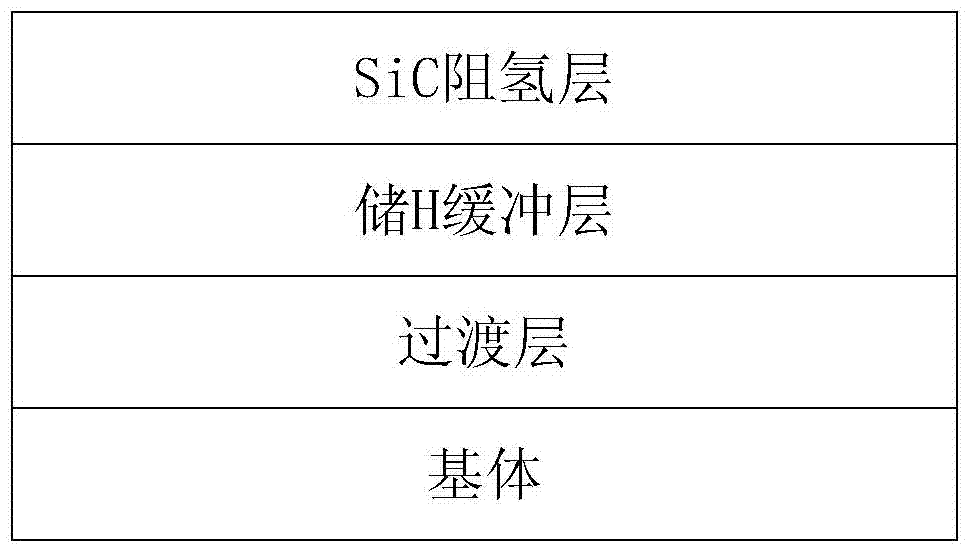A silicon carbide hydrogen permeation resistance coating for stainless steel and preparation method thereof
A kind of stainless steel and silicon carbide technology, applied in coating, metal material coating process, gaseous chemical plating and other directions, can solve the problems of resistance H thinking not working, heating up and adding catalyst to accelerate and so on
- Summary
- Abstract
- Description
- Claims
- Application Information
AI Technical Summary
Problems solved by technology
Method used
Image
Examples
Embodiment 1
[0043] The transition layer Ti / TiN is chosen to be plated on the substrate of austenitic stainless steel 316L, which is prepared by intermediate frequency magnetron sputtering. Firstly, metal Ti is plated, and the background vacuum is set to 1×10 -3 Pa, working pressure 0.6Pa, argon flow rate 120sccm, Ti target current 8A, voltage 550V, target base distance 80mm, time 10min, and the thickness of the obtained titanium layer is about 200nm. Deposit TiN on the basis of metal Ti, background vacuum 1×10 -3 Pa, working pressure 0.6Pa, argon flow 120sccm, nitrogen flow 15sccm, Ti target current 8A, voltage 530V, target base distance 80mm, time 20min, thickness about 350nm.
[0044] The H storage buffer layer was prepared by CVD method, and the specific parameters were as follows:
[0045] The precursor raw material is MTS, the carrier gas is H 2 (its purity is 99.8%), the diluent gas is argon, the deposition temperature is 1100°C, MTS+H 2 Flow from the first gradient 0.35L / min, th...
Embodiment 2
[0049] The transition layer Ti / TiN is chosen to be plated on the substrate of austenitic stainless steel 316L, which is prepared by intermediate frequency magnetron sputtering. Firstly, metal Ti is plated, the background vacuum is 1×10-3Pa, the working pressure is 0.3Pa, argon The flow rate is 90sccm, the Ti target current is 8A, the voltage is 560V, the target base distance is 80mm, the time is 10min, and the thickness is about 200nm. Deposit TiN on the basis of metal Ti, background vacuum 1×10-3Pa, working pressure 0.3Pa, argon flow 90sccm, nitrogen flow 15sccm, Ti target current 8A, voltage 540V, target-base distance 80mm, time 20min, thickness of 350nm.
[0050] The H storage buffer layer was prepared by PVD method, and the specific parameters were as follows:
[0051] Use pure silicon target material, first pre-evacuate to 1×10 -3 Pa; then pass into Ar and C 2 h 2 Mixed gas for intermediate frequency magnetron sputtering, Ar / C 2 h 2 The flow ratio is 5, in the proce...
Embodiment 3
[0056] Coating the transition layer Ti / TiN on the substrate of 304 stainless steel: adopt the method of intermediate frequency magnetron sputtering: firstly, metal Ti is plated, and the background vacuum is set to 1×10 -3 Pa, working pressure 0.3Pa, argon flow rate 90sccm, Ti target current 8A, voltage 560V, target base distance 80mm, time 10min, Ti layer thickness 200nm. Then on the basis of metal Ti, the TiN layer is deposited by radio frequency power magnetron sputtering: the background vacuum is 1×10 -3 Pa, working pressure 0.3Pa, argon flow rate 90sccm, nitrogen flow rate 15sccm, sputtering power 100-200W, target base distance 80mm, time 25min, TiN layer thickness 450nm.
[0057] The H storage buffer layer was prepared by PVD method, and the specific parameters were as follows:
[0058] The precursor raw material is MTS, the carrier gas is H 2 (its purity is 99.8%), the diluent gas is argon, the deposition temperature is 1150°C, MTS+H 2 The flow rate is from the first ...
PUM
| Property | Measurement | Unit |
|---|---|---|
| thickness | aaaaa | aaaaa |
| thickness | aaaaa | aaaaa |
| thickness | aaaaa | aaaaa |
Abstract
Description
Claims
Application Information
 Login to View More
Login to View More - R&D
- Intellectual Property
- Life Sciences
- Materials
- Tech Scout
- Unparalleled Data Quality
- Higher Quality Content
- 60% Fewer Hallucinations
Browse by: Latest US Patents, China's latest patents, Technical Efficacy Thesaurus, Application Domain, Technology Topic, Popular Technical Reports.
© 2025 PatSnap. All rights reserved.Legal|Privacy policy|Modern Slavery Act Transparency Statement|Sitemap|About US| Contact US: help@patsnap.com

